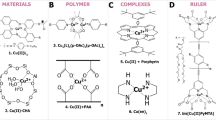Abstract
Since the initial work of Ingram (8,10) Electron Paramagnetic Resonance contributed considerably to research in hemoglobins. Now, 40 years later we review some of the results of the application of EPR to nitrosylhemoglobin (HbNO), as an example of the diversity of information which this technique can provide.
Similar content being viewed by others
References
Dickerson RE & Geis I (1983) Hemoglobin: Structure, function, evolution and pathology. The Benjamin/Cummins Publ. Co
As reported by L. Pauling in Proc. Natl. Ac. Sci. USA 22, 210 (1936)
Pauling L & Coryell CD (1936) The Magnetic properties and structure of the hemochromogens and related substances. Proc. Natl. Ac. Sci. USA 22: 159
Pauling I & Coryell CD (1936) The magnetic properties and structure of the hemoglobin, oxyhemoglobin and carbonmonoxy hemoglobin. Proc. Natl. Ac. Sci. USA 22: 210–216
Corycll CD, Pauling L. & Dodson R (1939) The magnetic properties of intermediates in the reactions of hemoglobin. J. Phys. Chem. 43: 825–839
Kendrew JC (1950) The crystal structure of horse metmyoglobin. General features: the arrangement of the polypeptide chains. Proc. Roy. Soc. A 201, 62–89
Boyes-Watson J, Davidson E & Perutz MF (1947) An x-ray study of horse methaemoglobin. Proc. Roy. Soc. A, 191, 83–129
Ingram DJE & Bennett JE (1955) Paramagnetic resonance in phtalocyanine, hemoglobin, and other organic derivatives. Disc. Faraday, Soc. 19, 140–146.
Zavoisky E (1945) Paramagnetic relaxation of liquid solutions for perpendicular fields. J. Phys. USSR, 9, 211
Benett JE, Gibson JF & Ingram DJE (1957) Electron resonance studies of haemoglobin derivatives. I. Haem plane orientations. Proc. Roy. Soc. A 240, 67–82
Perutz MF (1989) Mechanism of cooperativity and allosteric regulation in proteins. Quart. Rev. Bioph. 22, 139–236
Chien JCW (1969) EPR study of stereochemistry of Nitrosylhemoglobin. J Chem Phys 51, 4220–4227
Dickson LC& Chien JC (1979) Electron Paramagnetic Resonance of single crystal 15N-Nitrosyl-57 Femyoglobin. Biochem. Biophys. Res. Comm. 59, 1292–1297
Sugita Y (1975) Difference in spectra of α and β chains of hemoglobin between isolated state and in tetramer. Jour. Biol. Chem. 250, 1251–1256
Nagai K, Hori H, Yoshida S, Sakamoto H & Morimoto H (1978) The effect of quaternary structure on the state of the α and β subunits within nitrosyl haemoglobin. Biophys. Acta 532, 17–28
Frauenfelder H, Sligar S & Wolynes P (1991) The energy landscape and motions of proteins. Science 254, 1598–1603
Benesch R & Benesch RE (1967) The effect of organic phosphates from human erythrocyte on the allosteric properties of hemoglobin. Biochem. Biophys. Res. Comm. 26, 162–167
Monod J, Wyman J & Changeux JP (1965) On the nature of allosteric transitions: a plausible model. J. Mol. Biol. 22, 88–1
Trittelvitz E, Gersonde K & Winterhalter K (1975) ESR of Nitrosyl Haemoglobins: Normal α and β chains and mutants Hb M Iwate and Hb Zurich. Eur. J. Biochem. 51, 33–42
Szabo A & Perutz MF (1976) Equilibrium between six and five-coordinated hemes in nitrosylhemoglobin: interpretation of electron spin resonance spectra. Biochem. 15, 4427–4428
Twilfer H & Gersonde K (1976) Non-equivalence and inverse allosteric response of the α and β chains in hemoglobins. An electron spin resonance study of NO-ligated Hb Kansas. Naturforsch. 31C, 661–674
Morse R & Chan S (1980) EPR studies of nitrosyl ferrous heme complexes. Determination of an equilibrium between two conformations. Jour. Biol. Chem. 255, 7876–7882 (1980)
Neto LM, Nascimento O, Tabak M & Caracelli I (1988) The mechanismof reaction of nitrosylwithmet and oxymyoglobin: an EPR study. Biochem. Biophys. Acta, 956, 189–196
Sanches R (1988) Dehydration effects on the heme environment of nitric oxide hemoglobin. Biochem. Biophys. Acta 955, 310–314
Wajnberg E, El-Jaick L, Linhares M & Bemski G (1992) Nitrosyl hemoglobin: EPR components at low temperature. Eur. Biophys. J. 21, 57–61
Steinbach P, Ansari A, Berendzen J, Braunstein D, Chu K, Cowen B, Ehrenstein D, Frauenfelder H, Johnson JB, Lamb D, Luck S, Mourant J, Nienhaus U, Ormos P, Philipp R, Xie A & Young R (1991) Ligand binding to heme proteins: connection between dynamics and function. Biochem. 30, 3988–4001
Linhares M, El-Jaick L, Bemski G & Wajnberg E (1990) EPR studies of photolysis of nitrosyl hemoglobin at low temperature. Int. J. Biol. Macromol. 12, 59–63
Doetschman D, Schwartz S & Utterback S (1980) The electron spin distribution in nitrosyl hemoglobin. Chem. Phys. J. 49, 1–8
Waleh A, Ho N, Chantranupong L & Loew GH (1989) Electron structure of NO-ferrous heme complexes. J. Am. Chem. Soc. 111, 2767–2772
Feher G (1956) Observation of nuclear magnetic resonances via the electron spin resonance line. Phys. Rev. 103, 834–835
Feher G, Isaacson RA, Scholes CP & Nagel R (1973) Electronnuclear double resonance investigation on myoglobin and hemoglobin. Ann. N.Y. Acad. Sci. 222, 86–101
Höhn M, Hütterman J, Chien JCW & Dickinson LC (1983) 14N and 1H ENDOR of nitrosyllhemoglobin. J. Am. Chem. Soc. 105, 109–115
Kappl R & Hütterman J (1989) in Advanced EPR application in biology and biochemistry. ed. A.J. Hoff, Elsevier
Hütterman J, Burgard C & Kappl R (1994) Proton ENDOR from randomly orientated NO-ligated haemoglobin: approaching the structural basis for the R-T transition. J. Chem. Soc. Faraday Trans. 90: 3077–3087
Rights and permissions
About this article
Cite this article
Bemski, G. Contribution of Electron Paramagnetic Resonance to the studies of hemoglobin: the Nitrosylhemoglobin System. Mol Biol Rep 24, 263–269 (1997). https://doi.org/10.1023/A:1006842816800
Issue Date:
DOI: https://doi.org/10.1023/A:1006842816800




